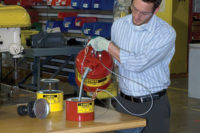
Silica dust claimed the lives of 764 workers who were part of a force of 5,000 who worked on the Hawk’s Nest Tunnel in West Virginia in 1930 and 1931. Until this time, the hazards of silica dust were not well known.
This and similar incidents showed the need for a workers’ right-to-know standard. “The right to know” is the basis of the hazard communication standard (29 CFR 1910.1200), which sets down guidelines for communicating hazardous chemical information to the workforce.
A good HAZCOM plan should cover four basic areas:
• What makes a chemical hazardous;
• Labeling;
• Material safety data sheets (MSDS);
• Training.
Chemical hazards
In order for employees to utilize labels and material safety data sheets, they need to understand what makes a chemical hazardous. Four items can help you identify a chemical as harmful.
a. How will you use the chemical? When you use it, will you be in close contact with the chemical?
b. How long will you be near the chemical? Is it a quick task or will you use it for extended periods?
c. What strength is the chemical? Is it diluted or pure strength?
d. What characteristics does the chemical have? Is it an acid or a caustic?
It is essential to understand a chemical’s characteristics and how they may affect you. Any of the following would make the chemical hazardous:
•Corrosive– materials that can attack and chemically destroy exposed body tissues. Oftentimes people think corrosives are only acids, but bases can be just as corrosive.
Acids: liquids with a pH of less than 7. Tomato juice has a pH of 4, which is an acid; on the other hand, sulfuric acid in a car battery has a pH of 1 and is definitely hazardous.
Bases: strong bases called caustics are also corrosive. Baking soda would be a mild base material with a pH of 8. Household ammonia (pH of 11) is a base we are all familiar with, and also sodium hydroxide (caustic soda) with a pH of 13, which is definitely corrosive.
•Toxic– a chemical that can cause illness or death. It could be a poison such as arsenic or a chemical like formaldehyde, which is a carcinogen.
•Flammable liquid– liquid that catches fire easily — a flash point less than 100 degrees Fahrenheit, such as gasoline.
•Oxidizer/Reactive– chemicals that promote oxidization (which is a form of chemical reaction) such as rusting, or chemicals that react with each other.
•Compressed gas– typical forms are propane or gases used for welding and burning.
•Explosive– chemicals that explode when heated, shocked or pressurized.
•Radioactive– a chemical that will emit radioactivity.
•Carcinogen– a chemical that has been found to cause cancer.
Labeling
A labeled container will provide basic information on its contents, including:
• Safe handling/storage procedures;
• Health/physical hazard(s);
• Primary hazard(s);
• First-aid treatment;
• Identity of the chemical.
When labeling containers in the workplace, a color-coded label can be used. Colors and numbering correspond with the NFPA diamond. A person can quickly identify the chemical’s hazards:
Blue = Health
Red = Flammability
Yellow = Reactivity (Note: Some newer labels have orange in place of yellow to identify physical hazards.)
White = Personal protective equipment (PPE) required
Hazards are gauged by the numbers zero to four, with four being the greatest hazard.
MSDS
The MSDS will give you detailed information on a chemical such as:
• Chemical identity;
• Physical and chemical characteristics;
• Physical and health hazards;
• Primary routes of entry;
• PEL, TLV, other exposure limits;
• Whether it is a carcinogen;
• Precautions for safe handling/use;
• Recommended engineering controls;
• Emergency first-aid procedures;
• Date of preparation;
• Name, address, phone number of manufacturer, importer, responsible party;
• ANSI recommendations (if any);
• The MSDS will also provide information regarding: signs and symptoms of exposure; PPE; spill and leak cleanup; labeling information.
Training
Employees must be trained in hazard communication each year. Training is best in a workshop form. Go through basic information about chemical identification, labeling and use of an MSDS. Then break the class into groups and have three or four containers marked with chemical names, how the chemical will be used and exposure to the employee. Have MSDS for the chemicals and blank color-coded labels.
Have them identify why the chemical is hazardous by listing:
1. How are you going to be using the chemical?
2. How long are you going to be near the chemical?
3. What strength is the chemical?
4. What characteristics does the chemical have? Is it an acid or a caustic?
Provide a list of questions that will direct them to utilize the MSDS sheet. The group will then label each container with color and number code. These activities will assure you that trainees understand the tools of hazard communication.
